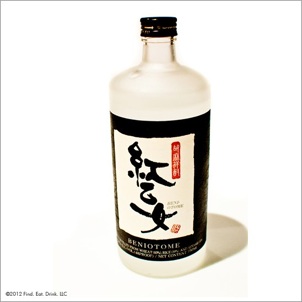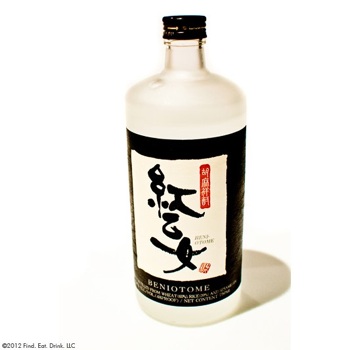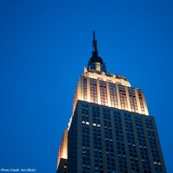Shochu, Soju, Japan, Sake, Japanese, Distilled Liquor, Distilled Spirit, Sakaya, Umi No Ie, Uminoie, Kyushu, Fiery Liquor, Sweet Potato, Barley, Soba, Buckwheat, Brown Sugar, Rice, Sesame, Date, Mold, Koji Kin, Imo, Mugi, Kokuto, Kome, Goma, Detsu,Shirokoji, Kikoji, Kurokoji, Otsushu, Osturui, Koshu, Korui, Ku, What to eat with Shochu, What to Pair with Shochu, What pairs with shochu.


Shochu
February 16, 2010
What
A clear distilled spirit from Japan.
Why
A flexible liquor with various flavor profiles that can be as clean as vodka or as nuanced and full-bodied as single malt scotch.
Consider
The alcoholic content is usually 25%, although sometimes it can be as high as 42% or more. Known for causing fewer hangovers.
Not that long ago, shochu was considered a poor man’s drink and said to have all the delicacies of drinking dishwashing liquid. That’s all changed. Now the drink formerly known as rotgut is enjoying star status in Japan, outselling sake, and starting to get A-list attention in the United States. But shochu certainly isn’t new. The first documentation dates back to being served on the Japanese island of Kyushu in the 1500’s. They still make shochu on the island, the only territory not to make any other alcoholic beverage. What is new are premium brands, which have elevated the taste and the drink’s prominence.

The essential difference between sake and shochu is in its production. Sake is brewed, shochu is distilled. Shochu has less calories - about 35 calories per 2 ounces. By law, it has less alcohol than many other liquors - 45 percent or less. It’s said to cause less of a hangover - due to its distilling process, many of the impurities are eliminated during manufacturing. And it’s thought to be healthy - it encourages production of enzymes, which break down blood clots (a preventative measure for heart attacks and strokes).

Shochu, which translates to “fiery liquor” can be consumed straight up, on the rocks, with fruit juice or tea, mixed with hot water, or as a cocktail. Like vodka, shochu can be distilled from various types of ingredients that contain natural sugar, such as potato, rice, wheat and barley, resulting in a very flexible spirit with a wide array of styles and tastes.





米 Kome (Rice): lightly refined sweetness similar to sake.



Unlike other spirits distilled from a variety of ingredients, shochu is also made from a mold (koji kin 麹菌) that breaks down the starches in the base ingredient and gives the shochu its unique smell. These molds also have an impact on the flavor and aroma profiles of shochu.
白麹 Shirokoji (white) has mild aroma and results in a sweet, mild, gentle tasting shochu. These shochu tend to be lighter in body.
黄麹 Kikoji (yellow) is a very sensitive mold that creates a fruity aroma and a fruity, light, supple tasting shochu. It is the same mold that is used in brewing sake.
黒麹 Kurokoji (black) is stronger and bolder on the nose and creates a sweet, rich, strong tasting shochu. It is known for making Okinawan awamori.

There are two types of classification for shochu based on the number of times the shochu is distilled and the method of distillation:
Otsushu / Osturui
The traditional method, which has been used since the 14th century. The shochu is distilled once in a pot still (tanshiki). It has a stronger aroma and taste from the base ingredient. It’s usually enjoyed on the rocks or mixed with hot water. You will also see this type of shochu called honkaku shochu.
Koshu / Korui
The more modern distillation method (since around 1949). The shochu is distilled several times and in a continuous still (renzoku shiki). This results in less aroma and less taste, and is usually mixed into cocktails.

Since shochu is a distilled spirit that usually is greater than 25% in alcohol content, it can be treated like any other liquor and can be left open for a long period of time without decomposition. Although it is always best to store you liquor in a cool, dark place.

Koreans drink a similar drink called soju, which is rice-distilled. It also has recently gained enormous popularity and Anheuser-Busch distributes a soju brand called Ku.
To add to the confusion around the two drinks, in New York and California there is a loophole in liquor laws allowing restaurants without a full liquor license to serve soju, as long as it contains no more than 24 percent alcohol. Since this doesn’t apply to shochu, you may see some of the Japanese spirit labeled as the Korean soju.

In Japanese, the common toast is “kanpai” (translating to “dry your cup”). But if your cup goes dry, it’s customary to wait for your drinking companion to replenish your glass and you refill theirs.
Recommendations

Chef Koji Hagihara of Hakata Tonton recommends:
- Tsukushi Mugi Shocyu | White Label
The best (barley - mugi) shochu. Very rich flavor and deep tastes. Recommended to drink on the rocks.
- Tsukushi Mugi Shocyu | Black Label
Mugi Shochu finishes in the highest high, deep aroma. Recommended to drink on the rocks.

Umi No Ie restaurant owner Matsumi recommends:
- Kappa No Sasoi-Mizu (河童の誘い水): distilled from sweet potato, really smooth, goes with anything.
- Heihachiro (平八郎): sweet potato-based, stronger flavor.

Sakaya sake store owner Hiroko recommends:
- Beni Otome (紅乙女): made from roasted sesame seeds. (Available at Sakaya and by the glass at EN Japanese Brasserie and Greenwich Grill).

Where to buy and drink shochu.

Article




















Related Articles



















